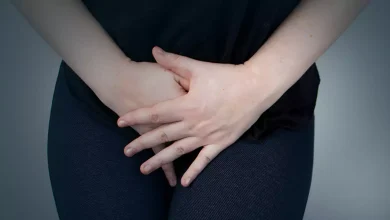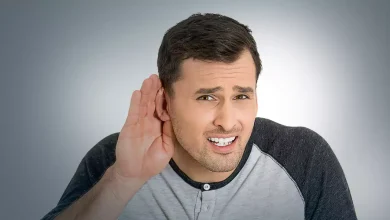All about Baldness
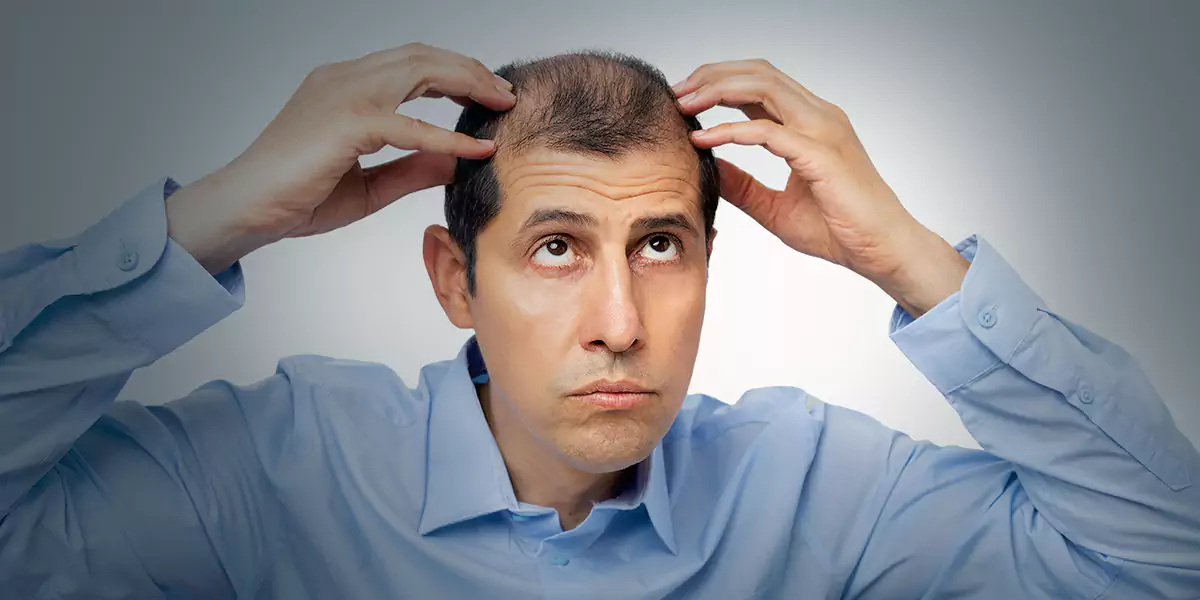
What is Baldness?
A healthy person loses around 100 strands of hair every day but it’s a normal pattern and a part of the hair’s growth cycle as new hair strands grow again replacing the hair you shed. But if your hair sheds more than normal and new hair does not replace it, then slowly all hair from your head will be gone and this condition is called baldness. People usually start shedding more hair as they age but it can happen to young people also due to reasons that can be hereditary, changes in hormones, medications, etc.
What are the Types of Baldness?
The types of baldness can be divided into four types including:
Androgenic alopecia: The reason for this type of hair loss is hereditary and it affects both genders in the forms of hair loss in women and male pattern baldness.
Telogen effluvium: Here the hair sheds very fast in a short period and it mostly happens after you go through some stress which can be physical or emotional. Hormonal changes can also cause this type of hair loss.
Alopecia areata: This type of baldness happens because of an autoimmune disease and it can cause the shedding of hair from all over your body.
Anagen effluvium: Anagen effluvium occurs because of certain medical treatments, like chemotherapy.
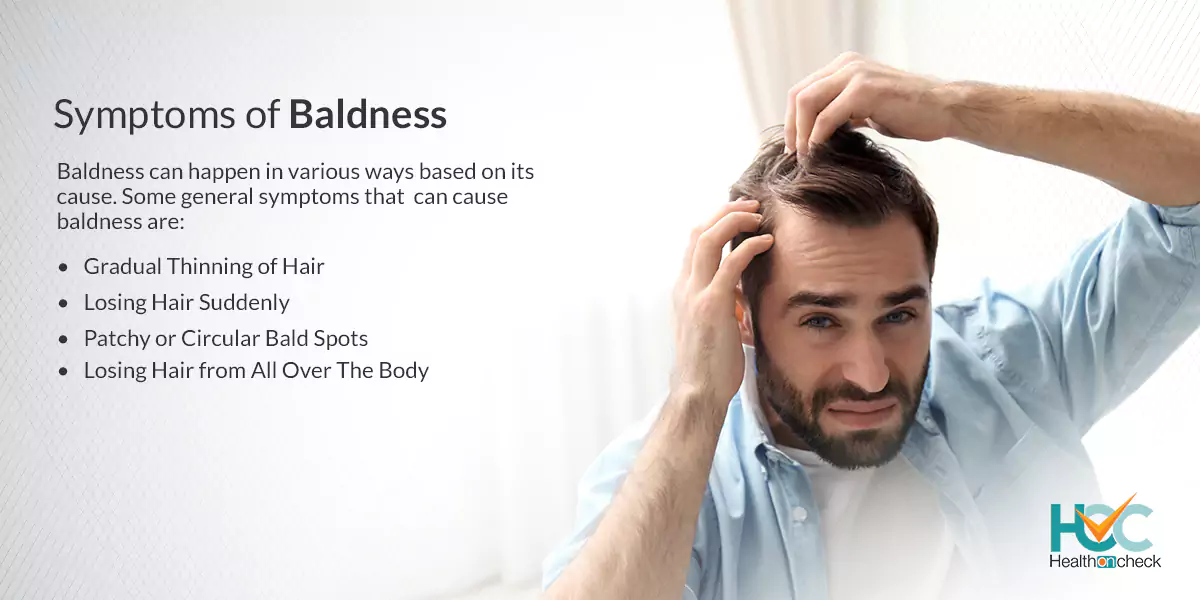
What are the Symptoms of Baldness
Baldness can happen in various ways based on its cause. Some general symptoms that can cause baldness are:
Gradual Thinning of Hair: It’s a very common type of hair loss that can affect anyone irrespective of gender and age. Here you will notice that in males, the hairline on the forehead becomes thin, and in females, there will be a broadening of the part in their hair. In older women, there is a common pattern which is receding hairline.
Losing Hair Suddenly: This mostly occurs because of any physical and mental shock which may lead to sudden hair loss. You will notice that a handful of hair may be shed while combing, and washing hair. It usually results in overall thinning of hair. It’s temporary.
Patchy or Circular Bald Spots: You will notice that you are losing hair in patchy or circular bald spots on your scalp, eyebrows, or beard along with the skin becoming painful or itchy before the bald spots begin to appear.
Losing Hair from All Over The Body: If you went through some medication, especially chemotherapy, or if you have cancer, then it can cause full body hair loss. The hair normally comes back when you get cured of cancer and stop chemotherapy.
What are the Causes of Baldness?
Some common causes of baldness are:
Heredity: Heredity is the most common cause of baldness. If you have a family history of early baldness then the genes may pass on to you from your parents. It generally occurs gradually and in males, there will be receding hairline and bald spots while in women there will be thinning hairline.
Changes in Hormones: Hair loss may happen because of hormonal changes such as menopause, pregnancy, childbirth, and thyroid. An increase in an androgen called dihydrotestosterone (DHT) can cause male pattern baldness
Medical Conditions: Certain medical conditions especially cancer and alopecia areata ( an immune system disorder) can cause hair loss. Alopecia areata along with baldness can also create other problems like scalp infections like ringworm and trichotillomania, a hair-pulling disorder.
Medications: Medications such as chemotherapy, a drug given to cancer patients can cause full-body hair loss. Medicines for conditions like depression, arthritis, cardiovascular diseases, thyroid, gout, and high blood pressure may also lead to hair loss but these are temporary as you stop the medications, the hair will grow back.
Radiation Therapy: If radiation therapy is used in your head then you may lose hair and it will not be like before even after the hair grows back.
Stress: Any kind of physical or mental stress can cause hair loss but it’s not permanent.
Lack of Nutrients: If you don’t have certain types of nutrients, especially iron, biotin, and zinc in your diet, then it might cause baldness.
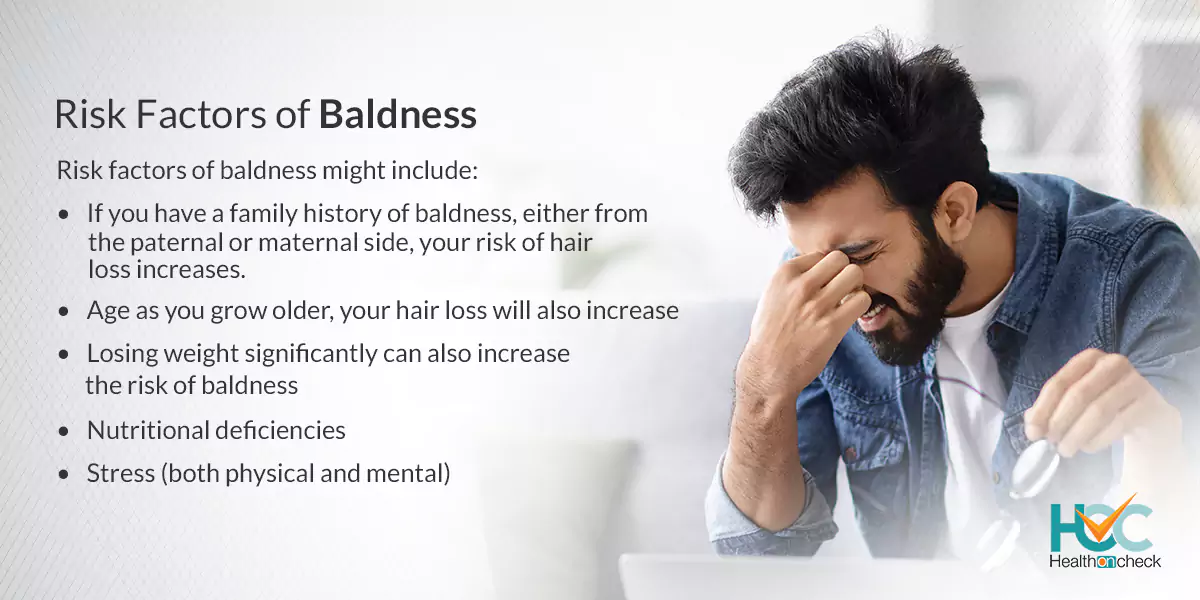
What are the Risk Factors of Baldness?
Risk factors of baldness might include:
- If you have a family history of baldness, either from the paternal or maternal side, your risk of hair loss increases.
- Age as you grow older, your hair loss will also increase
- Losing weight significantly can also increase the risk of baldness
- Nutritional deficiencies
- Stress (both physical and mental)
- Certain hairstyles including braids, hair extensions, or tight ponytails can trigger hair loss
What are the Complications of Baldness?
Baldness can cause emotional problems as you may start having an inferiority complex along with mental issues such as depression and anxiety. It can cause some serious complications including skin cancer, particularly squamous cell carcinomas, and basal cell carcinomas if your head is more exposed to sunlight. To protect your head from direct exposure to sunlight, cover your head with a scarf, cap, etc while going outside and apply sunscreen on your head regularly.
How Baldness is Diagnosed?
If you notice more shedding of hair than normal, it may be because of hair loss which can lead to baldness. Your doctor may take a physical test and ask questions regarding your family history, diet, hair care routine, etc. You may have to go for some tests to diagnose hair loss including:
Blood test: A sample of your blood might be sent for a test to detect the cause of baldness.
Pull test: In this test, your doctor will gently pull your hair to check how many come out. This test is helpful to find out the stage of hair loss.
Scalp biopsy: Samples of some hairs will be plucked from the scalp and they will be checked under a microscope to examine if any kind of infection is causing hair loss.
Light microscopy: In this test, a special instrument is used to detect hairs trimmed at their bases and it helps to find out possible disorders that are causing hair loss.
What are the Treatment Options Available for Baldness?
There are treatments available to reverse hair loss or slow it down and prevent baldness. The treatment options may include:
Medication: If your hair loss or baldness is because of some underlying conditions then treating that condition may prevent further hair loss or help in growing back hair again. If any particular medicine for some other disease is causing hair loss then your doctor may advise you to stop taking it or may replace it.
A few medicines to treat hair loss/ baldness are:
Minoxidil (Rogaine): Minoxidil is an over-the-counter (nonprescription) medicine available in the form of liquid, foam, and shampoo. To get the best results you have to apply it on the scalp skin daily one time for women and two times for men.
Minoxidil helps in the regrowth of hair or slowing down the rate of hair loss or both. The results do not come immediately and at least six months is required to avert further hair loss and regrowth of hair. This is also the amount of time needed to know whether this medicine is working for you or not. If you notice it’s working then keep using it to get the most out of its advantages. It may have some side effects such as scalp irritation or unwanted hair growth on the skin near the face and hands.
Finasteride (Propecia): Finasteride is a prescribed medicine usually for men. It comes in a pill form which you have to take daily. It slows the process of hair loss, along with helping in new hair growth. It might take some months to show the results, so you have to keep taking it regularly for a few months. This medicine may not be helpful for men above the age of 60. It has some side effects like reduced sex drive or sexual function but they are rare.
Other medications: Spironolactone (Carospir, Aldactone) and oral dutasteride (Avodart) are some other medicines that may prevent hair loss or help in the regrowth of hair.
Hair transplant surgery: Nowadays hair transplant surgery is very common to get back the hair you lost. During hair transplant surgery, a dermatologist or cosmetic surgeon will remove hair from a part of the head that has hair or from another part from where hair can be taken and transplant it to a bald part of the head. Each patch of hair has one to numerous hair (micrografts and minigrafts).
At times a huge strip of skin containing multiple hair groupings is taken to cover the bald patches. Hospitalization is not required in this type of surgery, but it is painful so you’ll be given sedative medicine so that you won’t feel any pain. There may be some side effects such as bruising, bleeding, swelling, or infection. Post-surgery care is very important to make it a success.
Platelet-rich plasma (PRP): In this treatment process, a sample of your blood will be taken and plasma will be separated. Then this platelet-rich plasma will be injected into your scalp. It can be helpful to slow down hair loss along with encouraging new hair growth.
Living with Baldness
Baldness irrespective of its cause can be emotionally challenging and affect your self-confidence. You may avoid social gatherings or may get an inferiority complex. Discuss with your doctor if there is any way to get your hair back or if you are in the process of hair loss then take medications to reverse it or slow it. There is no need to lack confidence as your baldness does not define who you are. Take it as a part of life and carry on with your life normally and find ways to thrive and feel great, no matter how much or how little hair you have. If sometimes you feel low then you can share your feelings with your near and dear ones.
Whom to Consult?
If you notice unusual hair loss, sudden or patchy hair loss, or more than usual hair loss when combing or washing them then meet a dermatologist and discuss the signs and symptoms you are noticing to avoid significant permanent baldness. Sudden hair loss can happen because of some underlying medical condition that may need medical treatment. Get yourself diagnosed to check the cause and start treatment accordingly.

